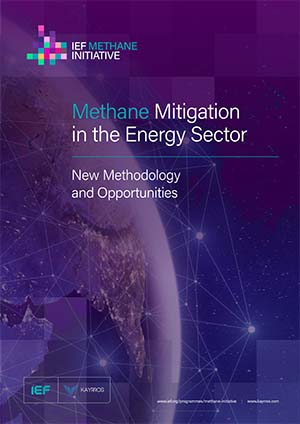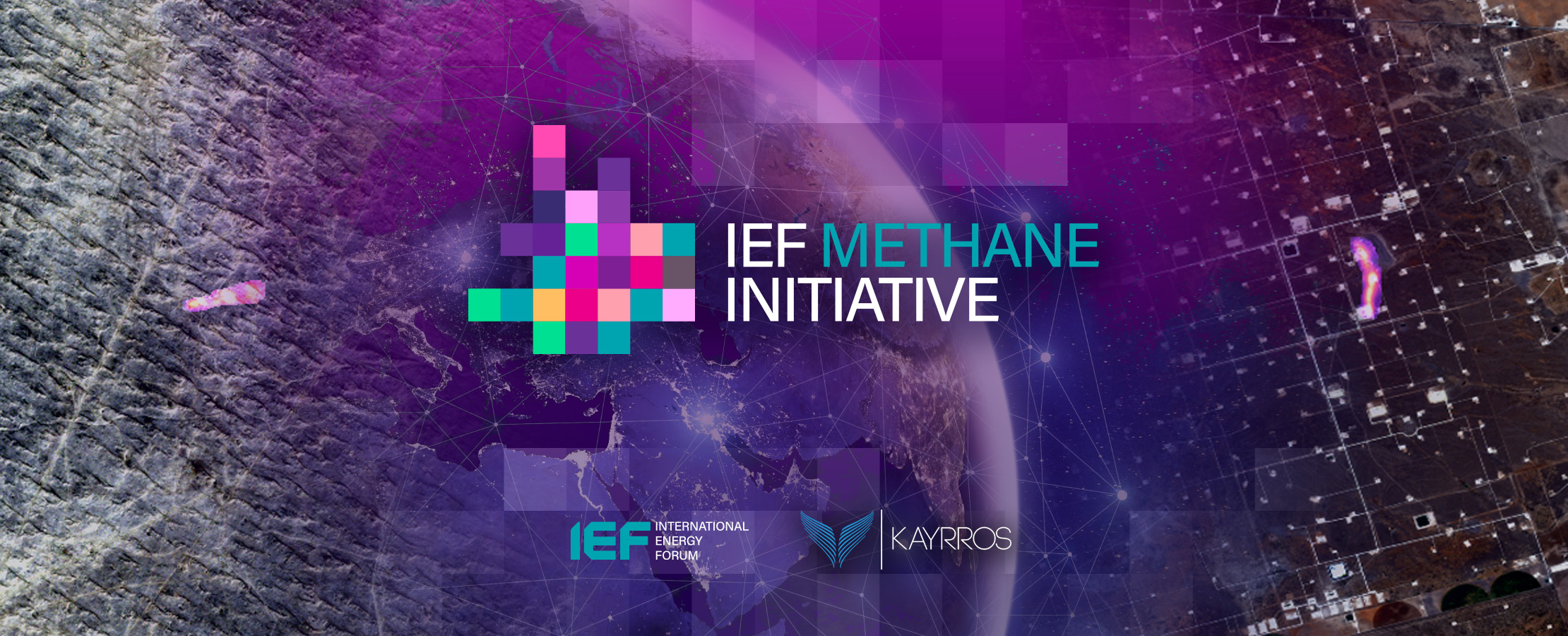IEF Methane Initiative
Methane Measurement Methodology Project
The International Energy Forum (IEF) launched the IEF Methane Initiative in June 2021 to develop a methane emissions measurement methodology, enabling its member countries to collect standardized data to mitigate methane emissions from the energy industry and address its share of climate change goals.
Created in partnership with Kayrros, an advanced observation and data analytics company, the Methane Measurement Methodology Project aims to close the gap between observed methane emissions and those reported at the company level.
Experts estimate that currently reported methane emissions are about 10 percent of what is observed by satellite. The new methodology will allow IEF member countries to consider the best available data on methane emissions, define their historical methane baseline and set mitigation goals in a transparent and consistent manner.
With these targets, IEF members would be able to present credible plans for reducing their countries' methane emissions in their Nationally Determined Contributions (NDC) ahead of the 26th UN Climate Change Conference of the Parties (COP26) in November 2021.
The initiative falls under the IEF's mandate to explore carbon management options, data and metrics to help governments and industry stakeholders to make better informed and more cohesive trade and investment decisions, supporting a swift recovery to sustainable and inclusive economic growth.
The methodology will rely on satellite data from Sentinel-5P, part of the Copernicus constellation of satellites operated by the European Space Agency, along with artificial intelligence and advanced algorithms to detect and measure methane emissions. It would also integrate corporate data as well as country-level data.
Prepared jointly with IEF members, the methodology would provide countries and the sector with a range of tools to match their capabilities and needs for emissions reductions. The scope of this project is limited to emissions produced by the energy industry and excludes agricultural and other methane emissions.
Kayrros is the leading global asset observation platform built on fundamental science, strong R&D and leading technology. Harnessing satellite imagery and multiple sources of unconventional data with machine learning, natural language processing and advanced mathematics, Kayrros is able to monitor and measure energy and natural resource activity worldwide.
The initiative comes in the lead-up to the 17th Ministerial Meeting of the IEF, due to be held at the end of the year, devoted to "Orderly Transitions in A New Era: Energy Security and Shared Goals Post COVID-19".
What is Methane and How Does It Contribute to Climate Change?
Methane (CH4) is the main component of natural gas. When burned, it produces about half the carbon emissions of coal. But when methane enters the atmosphere, it becomes a powerful greenhouse gas.
Today, methane is the second highest contributor to global warming after carbon dioxide.
And the problem is getting worse - atmospheric concentration of methane is increasing faster than at any time since the 1980s, in part due to methane leaks.
Methane leaks are hard to monitor using traditional methods and are frequently underreported or even left out of emissions inventories.
Studies show that at any one time, there are around 100 high-volume methane leaks happening in the world. The US Environmental Protection Agency estimates 570 metric tonnes of methane leak into the atmosphere every year.
A global measuring tool
Methane emissions have been overlooked in the climate conversation for years, despite the fact that at least 25 percent of today's global warming is driven by methane produced through human activity - including from the oil and gas industry.
The good news is a large part of the methane emissions in the energy sector can be reduced at little or no cost. A lack of accurate information has been a major issue. Current studies estimate that only about 10 percent of observed methane emissions are reported.
Increasingly, scientists and policymakers are recognizing that methane emissions have a crucial impact on climate change, and that better information is needed.
That's why the International Energy Forum (IEF) is developing collaboratively a global tool to empower all member countries to accurately measure and manage methane emissions for the first time.
"Methane emissions are a leading driver of climate change, second only to carbon dioxide," said IEF Secretary General Joseph McMonigle. "Therefore, it is critical for countries to focus on methane reductions for the world to address climate change, and this IEF methane initiative will help member countries make progress in meeting our climate goals."
The new technologies improving accuracy
The IEF's initiative is possible thanks to new technologies that are transforming how we measure methane emissions.
Researchers have found that satellite and drone data can accurately identify large methane emissions from onshore oil and gas operations. Combining this data with artificial intelligence algorithms means technology is now able to pinpoint leaks and track methane emissions in real time.
Building on this technology, the IEF partnered with data analytics company Kayrros to build a standardized methodology for measuring methane emissions in collaboration with its member countries. This tool will enable IEF members around the world to not only track methane emissions produced by the energy industry – but to accurately measure and manage them.
Our approach will enable countries to bring accurate, standardized and credible baseline numbers to discussions at the COP26 climate change summit in November 2021. Methane is a low hanging fruit that can help countries as they scale up their national commitments to reach ambitious climate targets.
An international imperative
The IEF's position as the largest energy organization in the world means it is ideally placed to make standardized methane measurement and management a global priority.
Using our methodology, countries will be able to get a clear picture of their methane emissions and make informed decisions about how to reduce them.
Sharing accurate and reliable data will also help to build international trust and promote informed discussion on the relationship between energy, technology, the environment and the economy.
Building on existing voluntary initiatives, agreeing on a methodology for accurate data on methane emissions is a key step towards a collaborative culture of ongoing measurement and setting and achieving emissions targets.
Cutting emissions is the fastest way to immediately avert climate risks – including crop loss, wildfires, extreme weather and rising sea levels.
Now is the time to make informed, data-driven decisions to tackle methane emissions from the energy industry, and the IEF is committed to supporting its global members in this aim.
IEF Methane Report
The IEF has published a report to mark the conclusion of the initiative. The result of four months of work, including workshops and bilateral meetings with IEF members, in collaboration with advanced data analytics firm Kayrros, the report comprises three key metrics: methane intensities of hydrocarbon production across the supply chain, super-emitter events, and flaring intensities.
 Download the report PDF
Download the report PDF Q&A
What is the Methane Measurement Methodology Project?
- The Methane Measurement Methodology Project aims to support efforts by member governments to develop a standardized methodology to accurately measure methane emissions from the energy industry and then reduce these emissions over time.
- The methodology is designed to enable IEF members to prepare methane mitigation targets in their Nationally Determined Contributions (NDC) for the 26th Conference of the Parties (COP26) of the UN Framework Convention of Climate Change in November 2021.
- The methodology—created in partnership with Kayrros, an advanced observation and data analytics company—would address the discrepancy between atmospheric observations and methane emissions reported by energy companies.
- The methodology would define the historical methane baseline and set mitigation targets in a transparent and consistent manner for energy-industry methane emissions.
Why the IEF Methane Initiative matters
- Eighty percent of countries have already included methane in their greenhouse gas targets of their NDC, but only five percent have set specific targets for methane reduction in the energy industry.
- The United Nations Environment Program reports that the energy sector can reduce methane emissions from oil, gas and coal by 50 percent at a low cost, and deliver 0.1℃ in avoided warming by 2030.
- Armed with methane data, IEF members would be able to advance methane reduction initiatives to meet short-term objectives and long-term goals to reduce greenhouse gas emissions.
- A pound of methane traps 25 times more heat in the atmosphere than a pound of carbon dioxide over its lifetime. In the first 20 years after being released into the atmosphere, methane is 80 times more potent than carbon dioxide at trapping heat.
Why is the IEF leading this initiative?
- The IEF is well positioned to advance this because it is the largest energy organization in the world, with member countries accounting for 90 percent of the energy market.
- The IEF is uniquely positioned to work in partnership Kayrros and IEF member countries to develop a credible and recognized global standard for methane emissions measurement.
- With a new methodology, members can be confident in the opportunity to bring methane to the top of the climate agenda.
Why now?
- For too many years, methane has been discounted in the climate conversation. At present, most countries do not accurately measure their methane emissions. Experts forecast that what is currently reported is about 10 percent of what is observed by satellite.
- Scientists and policymakers are increasingly recognizing that methane reductions are crucial to achieving short-term climate goals. Slowing the rate of climate warming can help avert the most acute climate risks, including crop loss, wildfires, extreme weather and rising sea levels.
- As the world approaches COP26, countries are expected to update their NDCs and methane reductions should be a key factor. Reducing methane emissions is one of the most achievable objectives in the battle against global warming
- The energy industry can reduce methane emissions to contribute to industry-wide efforts to reduce GHGs at zero to low cost.
How will the methodology work?
- The IEF and Kayrros will collaborate in the development of the methodology, which will rely as much as possible on atmospheric observations using governmental data sources such as satellite imagery from the European Space Agency.
- The methodology will also integrate corporate data as well as country-level data, particularly in tropical and/or offshore areas without satellite coverage.
- The methodology is developed jointly with IEF members in an iterative process; rather, it provides IEF members with a range of tools to measure, monitor and address methane emissions.
More details about methane
What is methane?
- Methane (CH4) is an odorless, colorless and highly flammable gas.
- It is a greenhouse gas that is emitted during energy production and processing of natural gas, coal and crude oil.
How is methane produced?
- Organic waste generates large amounts of methane as it decomposes.
- The major sources of methane emissions are wet lands, agriculture, primarily from livestock management; and waste management, primarily landfills and then energy production, including coal mining, natural gas systems, petroleum systems; biomass consumption, the burning of wood and other natural products.
How does methane contribute to climate change?
- At least 25 percent of today's warming is driven by methane from human actions.
- Methane's existence in the atmosphere is short compared to those of other greenhouse gases, but it is more efficient at capturing heat than other gases.
- Atmospheric emissions and concentrations of methane continue to increase, making it the second most significant human-influenced greenhouse gas after carbon dioxide.
Can methane be repurposed?
- Yes. Because methane can be captured during energy production, it can be reused to produce electricity, power vehicles and heat buildings.







